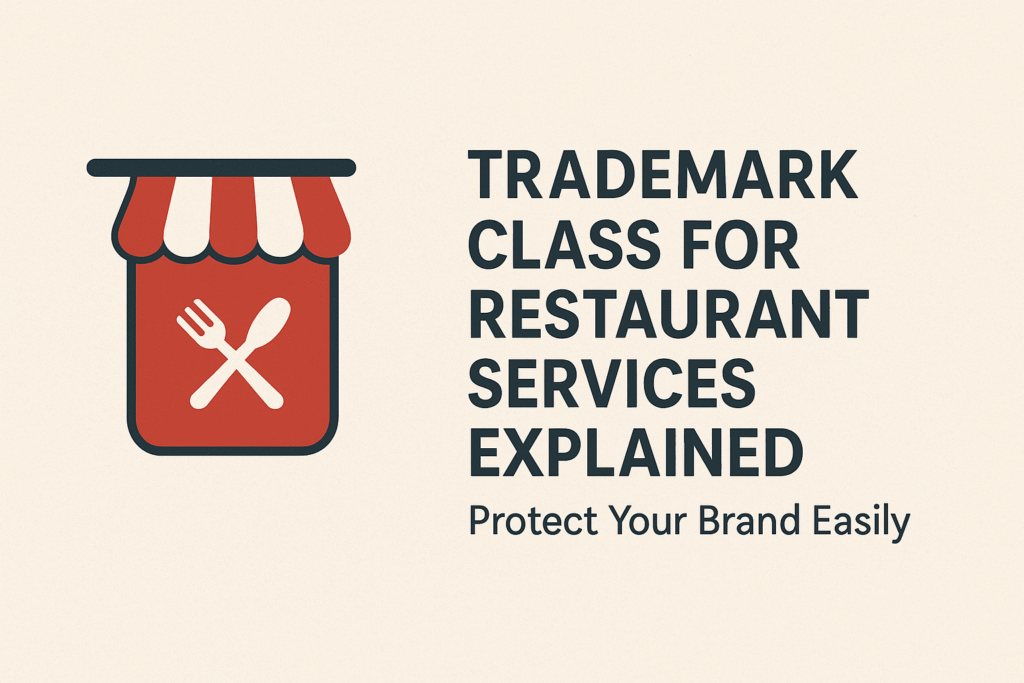In the current competitive food space, the name, logo, or tagline of your restaurant Trademark Class – it’s your identity. Whether you operate a café, cloud kitchen, fast food establishment, or a fine dining restaurant, legally protecting your brand is essential. That is where trademark registration comes into play.
However, many restaurant owners are often confused regarding one critical question:
👉 Which trademark class should I select for my restaurant according to the India Trademark System?
Don’t worry – this guide to Trademark Class for Restaurant Services will explain everything simply and clearly so you can register your brand correctly. Nothing complicated. Nothing confusing.
What a Trademark Means in the Restaurant Industry
A trademark is your unique identity, setting your brand apart from others in the food industry. A trademark can include:
✅ Restaurant Name (e.g., Domino’s, Barbeque Nation, Haldiram’s)
✅ Logo or Symbol
✅ Tagline or Slogan (e.g., “Finger Lickin’ Good“)
✅ Designs (for takeaway/delivery brand packaging)
✅ Unique product names (for packaged food)
Once your brand trademark is registered, no one else can legally use your brand, and you have the rights to act against any imitator.
Why Restaurant Owners Must Register a Trademark
Still unsure if a trademark is right for you? Here are some key reasons to get one today:
| Advantage | What It Means to You |
| ✅ Brand Protection | Nobody can use a similar name or logo |
| ✅ Legal Ownership | You are the legal owner of your brand as registered in a trademark |
| ✅ Customer Trust | A registered ™ or ® builds customer confidence |
| ✅ Franchise/Expansion Ready | Essential for business expansion or investment opportunities |
| ✅ Helps Prevent Copying | Stops competitors from copying your look and feel |
Without a trademark, another business could register your brand before you, legally preventing you from using your restaurant name.
Class of Trademark for Restaurant Services in India (IP India System)
In India, trademarks are classified into 45 classes based on the type of goods or services. Registering in the wrong class may lead to rejection or weak legal protection.
For the restaurant business, the main trademark class is:
✅ Trademark Class 43 – Services for Providing Food and Drink
Class 43 includes:
- Restaurants
- Cafés / Coffee Shops
- Hotels, Bars, and Lounges
- Cloud Kitchens / Takeaway Service
- Catering Service
- Delivery and Online Ordering Platforms
So if you provide any food service, dine-in, or takeout, Class 43 is the right choice. For more details, you can check the full guide here: Restaurant Trademark Class in India.
Class 30 vs Class 43 – Key Differences
Many restaurant owners confuse Class 30 with Class 43. Here’s the distinction:
| Class | Used For |
| Class 30 | Prepared or Packaged Food Items like ready-to-eat meals, spices, sauces, bakery goods |
| Class 43 | Food Service & Restaurants such as food trucks, cloud kitchens, dine-in establishments, catering |
✅ Choose Class 30 if you sell packaged food items, and Class 43 if you serve food to customers. If you do both, consider registering under both classes.
How to Register a Trademark for Your Restaurant (Step-by-Step Guide)
Step 1: Trademark Search
Before filing your application, search existing trademarks to ensure your name or logo isn’t already registered. You can search by Wordmark and Class 43.
Step 2: Document Preparation
Required documents:
- Application Details (Individual / Company / Partnership)
- Brand Name / Logo (JPEG FILE FORMAT)
- Address Proof
- Proof of Identity (Aadhar / PAN)
- Power of Attorney (if filing through an agent)
Step 3: File The Application Online
Submit your application using form TM-A.
Government Fee:
- Individual / Start-up / Small Business: ₹4,500 per class
- Company / Other: ₹9,000 per class
Step 4: Usage of ◊ Symbol
While the application is pending, you can start using the ◊ symbol with your brand name or logo.
Step 5: Examination and Publication
The government examines your application. If approved, it is published in the Trademark Journal for objection opportunities.
Step 6: Registration & Usage of ® Symbol
If there are no objections, you will receive the registration certificate and can use the ® symbol.
Common Mistakes to Avoid
| ❌ Mistake | ✅ Solution |
| Filing under the wrong class | Ensure the classification is correct before filing. |
| Using generic names (e.g., “Tasty Bites”) | Pick a unique and memorable name. |
| Filing without trademark search | Always search first to avoid conflicts. |
| Copying logos or fonts | Create a distinctive logo. |
How Long Does Trademark Registration Take in India?
- Filing to approval: 12–18 months (assuming no objections)
- Validity: 10 years (renewable indefinitely)
FAQ – Trademark Class for Restaurant Services
1. What trademark class is for restaurants in India?
Class 43 covers restaurants, cafés, catering services, and cloud kitchens.
2. Should I also register under Class 30?
Yes, if you sell packaged, branded food products like sauces, snacks, or bakery items.
3. Can I register before opening my restaurant?
✅ Absolutely! Registering early protects your brand from competitors.
4. Can someone oppose my trademark?
Yes, during the publication stage objections can arise. Always pick a unique name to reduce risks.
Final Thoughts – Protect Your Restaurant Brand Before It’s Too Late!
Your restaurant’s name and identity are valuable assets. Registering under Class 43 is the first step to building a legally secure and scalable brand.
Whether running a small food stall or planning a nationwide franchise, a trademark protects you from imitation and builds customer trust. For the complete step-by-step process, visit Restaurant Trademark Class Guide.

